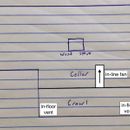Warming basement with in-line ventilation fan
GBA has given me enormous amounts of information over the last two years, but I finally have a question that I haven’t been able to answer through searching this site.
I am trying to come up with a long term plan for slowly retrofitting a 1930s farmhouse in Conway, New Hampshire, zone 6A (~7,700HDD). My wife and I have owned it for one year. The 2-story house is 1,200 square feet, with R15 cellulose plus R3 polyiso on the walls, R18 cellulose in the attic, cheap low-e double pane replacement windows, and drafts throughout. The cellar has uninsulated walls (CMU and some granite block), a dirt floor, and a 150sf unvented crawl space below an addition. The crawl space is dry and insulated (R20 walls, R8 floor).
Last winter we heated with a 35,000 BTU wood stove (primary) and four supplementary oil-filled space heaters. After 6 years of heating with wood at our old place, we plan to continue for the foreseeable future.
For several reasons we’re tackling the wet cellar first. In addition to a holistic plan to dry our cellar, we plan to insulate to R6 underslab with R20 reclaimed foam on the walls. We’ll be hiring a sprayfoam contractor to seal/insulate the rim beam and granite blocks.
Last winter we had to keep a 5000BTU space heater running almost continuously in the cellar to keep it over 50 degrees F. The wood stove is on the first floor, and it kept the first and second floors around 60 to 65 degrees.
I would like to keep the plumbing in the cellar from freezing without the energy penalty of the space heater. My thought is to use an inline fan to draw warm air into the cellar, via the crawlspace. I would first add vents in the floor between the first floor and the crawl. Then I’d run a very short duct through the sill beam that separates the crawl space from the rest of the cellar. An inline fan would draw air from the crawl space into the cellar.
Could this be an elegant solution to ventilating the crawlspace and keeping the pipes thawed? Or are these just the ramblings of a syphilitic mind? And if it might work, what size fan would be appropriate?
Thanks for your time,
Nick
GBA Detail Library
A collection of one thousand construction details organized by climate and house part










Replies
Hey Nick,
I'm sure you'll get some thoughts on your idea from GBA users soon. However the first thing that occured to me is that perhaps your crawl space is not staying warm because of the vents between it and the living space above, particularly if you don't have a fan that is actually pushing warm air down there, but instead because it is insulated. I wonder if you will have a problem once you are done insulating (and air sealing, of course) the basement.
I think Brian's got it nailed. Without air and heat loss to the exterior, your crawl space would naturally stabilize to the ground temperature which is somewhere around 50 degrees in your area. It is getting colder than that because of air leaks. As you stated above, the house is drafty. I expect the basement is worse. The chimney effect will naturally cause warm air to rise up and out of holes in your building envelope above grade. That air has to be replaced with cold outdoor air, and that typically happens at the bottom of the house. So, warm out out through the attic and cold air into the basement.
Air sealing is your friend. Try to locate and seal all exterior air leaks in the basement before even considering insulation. Your insulation plan is good, but the air leaks are what's causing your problems now, not the insulation. Use blower door directed air sealing if you can.
If your primary goal is not freezing the pipes, air sealing and insulation will probably suffice and no supplemental heat will be necessary.
Moving enough air to even partially condition a space as large as a basement with just ventilation fans--no dedicated duct runs--is very unlikely to succeed. Without a dedicated pathway such as ducting, and sufficient btus traveling with it, you will only get incidental space heating.
Peter